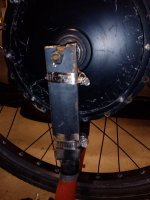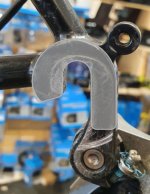MaximilianMM said:
... (I've been quoted $600 AUD which seems steep)...
Now I know that Singapore and Aussie dollars are sometimes smaller than Yankee dollars but AU$600 seems a bit extreme to me.
MaximilianMM said:
To clarify, are you saying brazing wouldn't offer as much fortification as welding? I had a quick Google and some sites seemed to be saying they can be similar in strength.
Yep ... and I have seen web sites refer to '
soldering' as '
welding'. Let us clarify the difference.
WELDING:
Two pieces of metal are joined together by melting a portion of both pieces and mixing them together at the molecular level. As they cool the metal forms new crystal structure between the two pieces fusing the bits together. This is your typical "joint" (and filler rod is usually added as well) but there also exists a form of welding called surfacing in which the second bit of metal is only the filler metal. This second method is sometimes used place a harder alloy than the base metal on the surface for wear purposes and in other instances used to fill in gaps or voids. The base metal must be the same element (
i.e. not Aluminum and Iron).
SOLDERING/BRAZING:
This is a surface bond ONLY. Two pieces of metal are joined together by heating the base pieces to a sufficiently high temperature that an filler alloy will melt into a liquid state and flow between them. This filler alloy seeps into gaps in the crystalline structure at the molecular level forming a mechanical bond between the surfaces as it cools back to solid state. The filler alloy base metal is usually a different base element(s) (
i.e. copper plus tin, aluminium, manganese, nickel or zinc used as filler for ferrous metals).
There are a few other specialized forms of 'welding' used including:
... explosive welding where two pieces of material a driven together by the force of an primary explosive. This method may be used to join dissimilar base metals together (
i.e. ferrous to aluminum). This method is sometime used in the marine industry to place ferrous metal hard points on aluminum boat hulls.
... friction welding where two pieces of material are rubbed together with enough force and frequency to produce sufficiently high temperature to soften both pieces of metal and mechanically bond their crystalline structures. This method is sometimes used to join cast/forged flanges to ends of steel tubes in the manufacture of drive shafts.
... others
The only real world use case I can think of where 'soldering/brazing'
might be stronger that 'welding' is in the jewelry industry where certain soft metals may be joined using silver-solder. All that being said, bronze filler alloy used to join ferrous metals can be EXTREMELY strong and for a period of time in the last century was the prefered fabrication method for bicycle frames (
usually lugged but not always). I know of the at least one instance of custom frame builder that uses a tig torch with bronze filler to join stainless steel components of his frames.
Side Note:
Bernzomatic makes a small inexpensive brazing kit (
when I say inexpensive that is in comparison to the AU$600 the frame builder wants). https://www.bernzomatic.com/Products/Hand-Torches/Manual-Ignition/WK5500OX
I have had one of these and used it to repair a steel tube structure for an patio awning. It is inadequate for large jobs (
goes through oxygen canisters like you would not believe) but it could be adequate for small tasks like attaching screw lugs to a steel bicycle frame or adding a bit of bronze filler metal to a oversized dropout slot.
Also note that the reynolds 631 is a 'work hardened' frame material. Any
sustained application of heat to the frame will weaken it somewhat in the areas closest to that point. https://www.reynoldstechnology.biz/materials/steel/s-631/
Leave us not forget adhesives. I used to drive a 1999 Honda Insight (
the original mass manufactured hybrid car). The aluminum body joints were all done with adhesive, heat and pressure. My 1990 Miyata CT7000 bicycle frame is made of carbon fiber over thin aluminum tubes. Those tubes are joined together with aluminum lugs via an adhesive. These days there are some extremely strong epoxy adhesives available to the consumer. I think that if I was faced with your problem that I might get a bit of 1/8 inch (3mm) or 1/4 inch (6mm) thick steel and bond it to the dropout area of you frame. Fill in the corners of the drop out with the same adhesive (
perhaps with some carbon fiber filler). Then reshape the dropout slot with a rat-tail (round) file. Optionally you could also braze or silver-solder that bit to the frame.
ScreenShot XXX.jpg
The one thing that I would absolutely NOT do is remove any additional material from that dropout.



